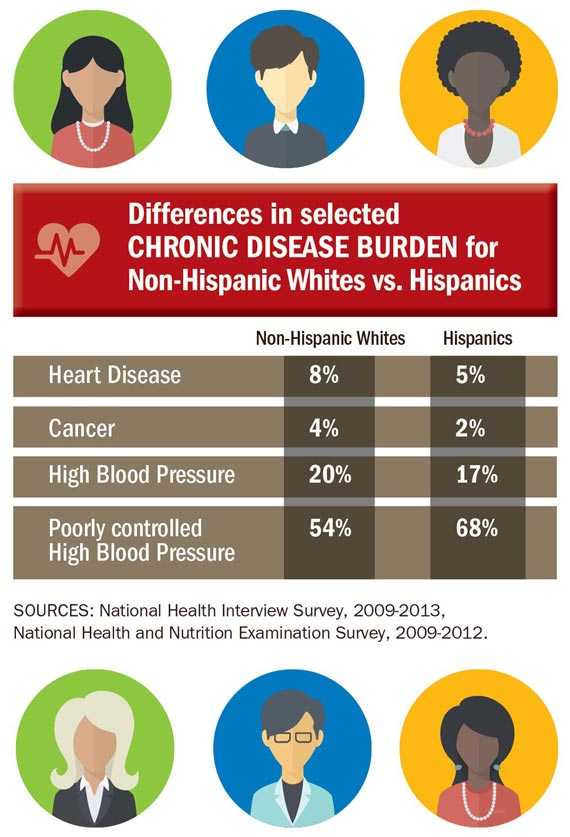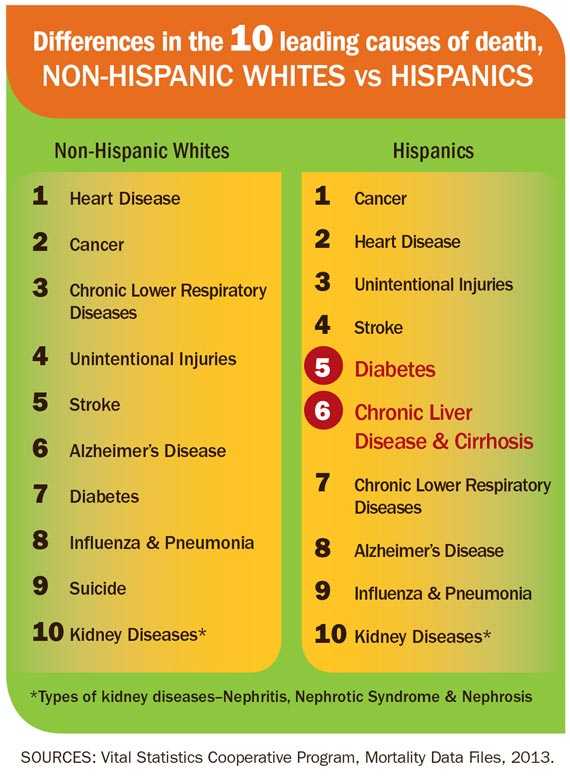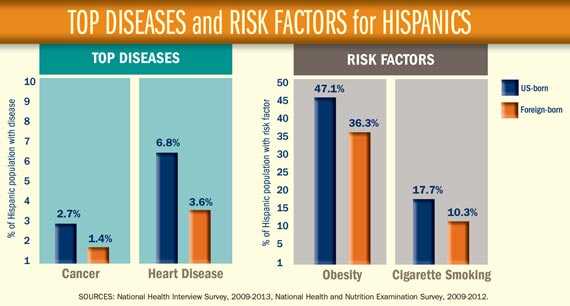Hispanic Health
¡A la Buena Salud! – To Good Health!

 1 in 6
1 in 6
About 1 in 6 people living in the US are Hispanic (almost 57 million). By 2035, this could be nearly 1 in 4.
 24%
24%
Hispanic death rate is 24% lower than whites ("non-Hispanic whites").
 50%
50%
Hispanics are about 50% more likely to die from diabetes or liver disease than whites.
Hispanics or Latinos are the largest racial/ethnic minority population in the US. Heart disease and cancer in Hispanics are the two leading causes of death, accounting for about 2 of 5 deaths, which is about the same for whites. Hispanics have lower deaths than whites from most of the 10 leading causes of death with three exceptions—more deaths from diabetes and chronic liver disease, and similar numbers of deaths from kidney diseases. Health risk can vary by Hispanic subgroup—for example, 66% more Puerto Ricans smoke than Mexicans. Health risk also depends partly on whether you were born in the US or another country. Hispanics are almost 3 times as likely to be uninsured as whites. Hispanics in the US are on average nearly 15 years younger than whites, so steps Hispanics take now to prevent disease can go a long way.
Doctors and other healthcare professionals can:
- Work with interpreters to eliminate language barriers, when patient prefers to speak Spanish.
- Counsel patients on weight control and diet if they have or are at high risk for high blood pressure, diabetes, or cancer.
- Ask patients if they smoke and if they do, help them quit.
- Engage community health workers (promotores de salud) to educate and link people to free or low-cost services.
Problem
Health risks differ among Hispanics.
Hispanics have different degrees of illness or health risks than whites.
- 35% less heart disease and 49% less cancer;
- A lower death rate overall, but about a 50% higher death rate from diabetes;
- 24% more poorly controlled high blood pressure;
- 23% more obesity;
- 28% less colorectal screening.
Hispanic subgroups have different degrees of health risk and more need to receive preventive screenings as recommended.
- Mexicans and Puerto Ricans are about twice as likely to die from diabetes as whites. Mexicans also are nearly twice as likely to die from chronic liver disease and cirrhosis as whites.
- Smoking overall among Hispanics (14%) is less common than among whites (24%), but is high among Puerto Rican males (26%) and Cuban males (22%).*
- Colorectal cancer screening varies for Hispanics ages 50 to 75 years.
- About 40% of Cubans get screened (29% of men and 49% of women);
- About 58% of Puerto Ricans get screened (54% of men and 61% of women).
- Hispanics are as likely as whites to have high blood pressure. But Hispanic women with high blood pressure are twice as likely as Hispanic men to get it under control.
Whether Hispanics were born in the US makes a difference.
- Cancers related to infections (cervical, stomach, and liver) are more common among Hispanics born in another country.
- Compared with US-born Hispanics, foreign-born Hispanics have:
- About half as much heart disease;
- 48% less cancer;
- 29% less high blood pressure;
- 45% more high total cholesterol.
- Social factors may play a major role in Hispanic health. Among Hispanics living in the US:
- About 1 in 3 has not completed high school;
- About 1 in 4 lives below the poverty line;
- About 1 in 3 does not speak English well.
*National Health Interview Survey data, 2009-2013 combined, for ages 18-64 years.
What Can Be Done
Federal government is
- Helping eligible Hispanics get insurance coverage through the Affordable Care Act.
- Working to build capacity in communities to use community health workers (promotores de salud) to help improve the health of Hispanic communities.
- Leveraging existing programs to improve community health services and access to preventive care.
- Making efforts to better represent all Hispanics in national health surveillance data and research studies and use the data to help improve Hispanic health.
Doctors and other healthcare professionals can
- Work with interpreters to eliminate language barriers, when patient prefers to speak Spanish.
- Counsel patients on weight control and diet if they have or are at high risk for high blood pressure, diabetes, or cancer.
- Ask patients if they smoke and if they do, help them quit. www.espanol.smokefree.gov • 1-800-QUIT-NOW
- Engage community health workers (promotores de salud) to educate and link people to free or low-cost services.
Community Health Workers (promotores de salud) can
- Use resources that have been developed to educate the Hispanic community about health risks and preventive services.
Everyone can
- Sign up for health insurance, if eligible, through the Affordable Care Act regardless of whether or not you have a pre-existing condition and find out if you are eligible for cost savings.
- Talk to your doctor or other healthcare professional about which cancer screening tests to get and how often, especially if you have a family history of cancer. Follow-up on any abnormal results.
- Make a strong effort to follow proven health tips such as quitting smoking, staying on medicine to control blood pressure and cholesterol, and maintaining a healthy weight by taking at least one brisk 10-minute walk, 3 times a day, 5 days a week.
- Learn about diabetes and how to prevent type 2 diabetes.
- Eat a healthy diet that is low in salt, low in total fat, saturated fat, and cholesterol, and rich in fresh fruits and vegetables.
Science Behind the Issue
Related Pages
- Vital Signs Issue details: Leading Causes of Death, Prevalence of Diseases and Risk Factors, and Use of Health Services Among Hispanics in the United States — 2009–2013, Morbidity and Mortality Weekly Report (MMWR)
- Vital Signs – Hispanic Health [PODCAST – 1:15 minutes]
- Vital Signs – Hispanic Health [PSA – 0:60 seconds]
- Promotores de Salud / Community Health Workers
- Health of Hispanic or Latino Population
- Cancer Prevention and Control
- Prevención y control del cáncer
- Diabetes
- Smoking & Tobacco Use
- Division for Heart Disease and Stroke Prevention
- Minority Health: Hispanic or Latino Populations
- Injury Prevention & Control
- Gateway to Health Communication & Social Marketing Practice
On Other Web Sites
- MedlinePlus – Hispanic American Health
- Million Hearts
- Million Hearts (Spanish)
- Know Stroke
- Know Stroke Video (Spanish)
- Choose My Plate
- elija MiPlato [PDF – 784KB] (Spanish)
- Physical Activity Guidelines for Americans [PDF – 8.35MB]
- Manténgase activo a su manera [PDF – 768KB] (Spanish)
- HHS Promotores de Salud/Community Health Workers Initiative
- U.S. Department of Health and Human Services, Office of Minority Health
- Hispanic Community Health Study (HCHS)/Study of Latinos (SOL)
- Pew Hispanic Center Fact Sheet. [PDF – 111KB]
- Page last reviewed: May 5, 2015
- Page last updated: May 5, 2015
- Content source:
Error processing SSI file


 ShareCompartir
ShareCompartir



